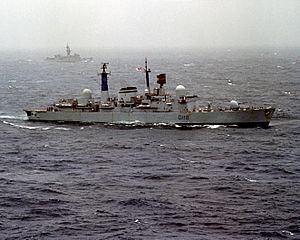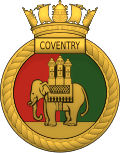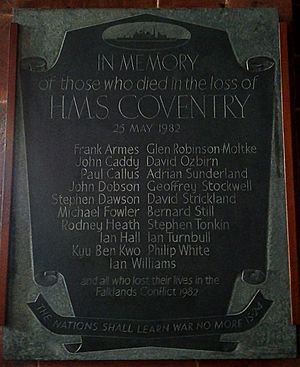HMS Coventry (D118) facts for kids

HMS Coventry
|
|
Quick facts for kids History |
|
|---|---|
| Name | HMS Coventry |
| Builder | Cammell Laird |
| Laid down | 29 January 1973 |
| Launched | 21 June 1974 |
| Commissioned | 10 November 1978 |
| Identification | Pennant number: D118 |
| Fate | Sunk by Argentine aircraft, 25 May 1982 |
| Badge |  |
| General characteristics | |
| Class and type | Type 42 destroyer |
| Displacement | 4,820 tonnes |
| Length | 125 m (410 ft) |
| Beam | 14.3 m (47 ft) |
| Draught | 5.8 m (19 ft) |
| Propulsion | COGOG (Combined Gas or Gas) turbines, 2 shafts producing 36 MW |
| Speed | 30 knots (56 km/h; 35 mph) |
| Complement | 287 |
| Armament |
|
| Aircraft carried | Westland Lynx HAS.Mk.1/2 |
HMS Coventry was a Type 42 (Sheffield-class) destroyer of the Royal Navy. A destroyer is a fast warship built to protect larger ships from smaller, faster attacks. Coventry was built by Cammell Laird in Birkenhead, England. She was started on January 29, 1973, launched on June 21, 1974, and officially joined the Royal Navy on October 20, 1978.
Sadly, HMS Coventry was sunk by Argentine Air Force A-4 Skyhawk aircraft on May 25, 1982, during the Falklands War.
Contents
What was the Coventry built for?
The main job of Type 42 destroyers like Coventry was to protect other ships from air attacks using missiles. They also had secondary roles, like fighting other ships or submarines. A total of sixteen Type 42 ships were built. Coventry was one of the first ones.
To save money, the first Type 42 ships were made a bit shorter. This made them not perform as well in rough seas.
Sea Dart Missiles
Type 42 destroyers were equipped with Sea Dart surface-to-air missiles. These missiles were designed in the 1960s to shoot down enemy aircraft. While they had some limits, Sea Dart missiles were successful during the Falklands War. Coventry herself was credited with shooting down three aircraft using these missiles.
Coventry in Service
Early Years: 1978–1982
Coventry officially joined the fleet on November 10, 1978. After some tests, the ship helped try out the new Westland Lynx helicopter. This was to make sure the helicopter could safely operate from this type of warship.
In 1980, Coventry went on its first big trip to the Far East. In September of that year, she became one of the first British warships to visit China in 30 years. On her way back, Coventry was sent to the Persian Gulf because the Iran–Iraq War had started. She patrolled there for six weeks. In 1981 and 1982, Coventry took part in many training exercises.
The Falklands War
In March 1982, Coventry was taking part in a training exercise near Gibraltar. When the Falklands War began, she and other ships were sent to the Falkland Islands. To help identify her, a Union Flag was painted on her bridge roof. A black line was also painted on her side. This was important because Argentina also had two Type 42 destroyers.
On April 27, Coventry entered the Total Exclusion Zone. This was a 200-mile area around the Falkland Islands where no enemy ships were allowed. Coventry, along with HMS Sheffield and HMS Glasgow, provided air defense for the aircraft carriers that followed behind.
Coventry in Action
Coventry played a big part in the Falklands War. Her helicopter was the first to fire Sea Skua air-to-surface missiles. On May 3, her Westland Lynx helicopter fired two Sea Skua missiles at an Argentine ship, the ARA Alferez Sobral. One missile hit a small boat on the ship, damaging it and injuring a crewman.
Coventry was also the first warship to fire Sea Dart missiles in a real battle. On May 9, she fired three Sea Darts at two Argentine Learjet aircraft. The missiles just missed the planes.
Coventry's captain, David Hart Dyke, believed his ship shot down two A-4C Skyhawks. However, these planes were actually lost due to bad weather. The first confirmed kill by Coventry was an Aérospatiale Puma helicopter. It was shot down by a Sea Dart missile, killing its three crew members.
Coventry was one of only three Type 42 destroyers providing air defense. After HMS Sheffield was lost and HMS Glasgow was damaged, Coventry was left to do this job alone.
The "Type 64" Tactic
After Sheffield was lost, a new plan was made to protect the fleet. The two remaining Type 42 destroyers were paired with two Type 22 frigates. This pairing was unofficially called "Type 64." These pairs would sail ahead of the main fleet to draw enemy aircraft away from the aircraft carriers. The idea was that if the Sea Dart missiles couldn't work, the shorter-range Sea Wolf missiles on the frigates could be used. Coventry was paired with Broadsword.
The Sinking of HMS Coventry
On May 25, 1982, Coventry and Broadsword were ordered to a position north-west of Falkland Sound. Their mission was to act as a decoy. They would try to draw Argentine aircraft away from other British ships at San Carlos Bay. This position was close to land, which made Coventry's long-range Sea Dart missiles less effective. Broadsword had Sea Wolf missiles, which were good for short-range defense.
At first, the plan worked. An Argentine A-4B Skyhawk was shot down by a Sea Dart missile from Coventry. The pilot was killed. Later, another A-4C Skyhawk was shot down by a Sea Dart while returning from a mission. The pilot ejected but was not found.
Then, the two ships came under attack by two waves of Argentine Douglas A-4 Skyhawks. The planes flew so low that Coventry's radar couldn't tell them apart from the land. This meant her Sea Dart missiles couldn't lock on. Broadsword tried to use her Sea Wolf system, but it stopped working during the attack.
One bomb bounced off the sea and hit Broadsword's flight deck. It didn't explode but destroyed the ship's helicopter. Coventry claimed to have hit one of the Skyhawks with small arms fire, but the plane returned safely.
The second pair of Skyhawks attacked Coventry 90 seconds later. Coventry still couldn't get a missile lock. She fired a Sea Dart missile to try and distract the planes and turned sharply to make herself a smaller target. On Broadsword, the Sea Wolf system was ready, but it couldn't fire because Coventry's turn put her directly in the way.
Coventry used her 4.5-inch gun and smaller weapons to defend herself. Her port 20 mm cannon jammed, leaving her with only rifles and machine guns. Coventry was hit by three bombs just above the waterline on her left side. One bomb exploded under the computer room, destroying it and the operations room. This hurt almost all the senior officers. Another bomb hit the forward engine room. It exploded under the junior ratings dining room, where the first aid team was. This caused major damage and flooding. The third bomb did not explode.
Within 20 minutes, the crew had to leave Coventry. The ship quickly turned over and sank. Nineteen of her crew members were killed, and 30 more were injured. One of the injured, Paul Mills, died later from his injuries. After the ship was hit, the crew waiting to be rescued sang "Always Look on the Bright Side of Life" from the movie Monty Python's Life of Brian.
Broadsword rescued 170 of Coventry's crew.
Remembering HMS Coventry

No one from Coventry received an award for bravery. However, CPO Aircrewman M J Tupper received a Distinguished Service Medal for his part in the rescue. After the war, a cross was put up on Pebble Island to remember the crew members who died.
David Hart Dyke, Coventry's commanding officer, wrote a book about the ship's story called Four Weeks in May: The Loss of HMS Coventry. The BBC made a documentary called Sea of Fire based on his book. The TV show Seconds from Disaster also featured the attack on Coventry in an episode called "Sinking the Coventry."
The wreck site of HMS Coventry is a protected site under the Protection of Military Remains Act. Five months after she sank, a team of Royal Navy divers explored the wreck. They found her lying on her left side in about 100 meters (328 feet) of water. This mission, called "Operation Blackleg," aimed to recover secret documents and equipment. They also made the remaining weapons safe. The dive team recovered some personal items and the ship's battle ensign. This flag was later given to the next ship named Coventry, a Type 22 frigate. They also recovered the Cross of Nails, which was given to the ship by Coventry Cathedral. This cross was loaned to the new Coventry until she was decommissioned. It is now carried on board HMS Diamond (D34), a Type 45 destroyer.
There is a memorial plaque for the crew of HMS Coventry at Holy Trinity Church, Coventry.
|
See also
 In Spanish: HMS Coventry (D118) para niños
In Spanish: HMS Coventry (D118) para niños

